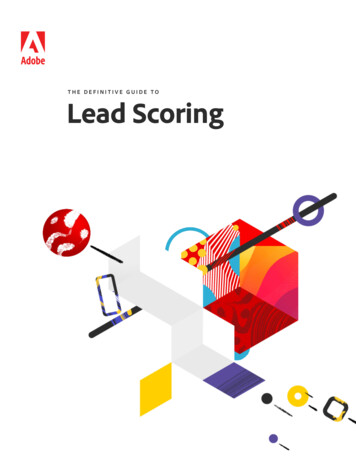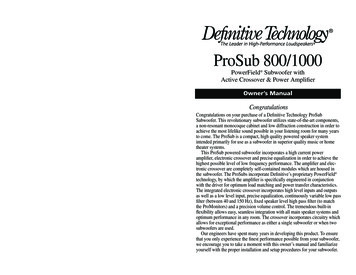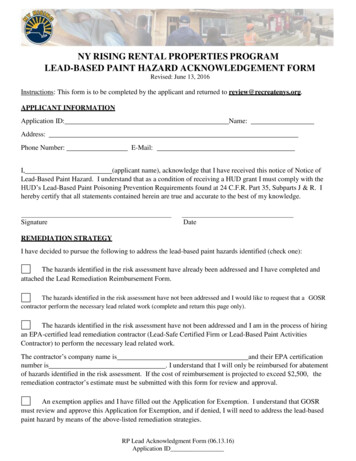
Transcription
THE DEFINITIVE GUIDE TOLead ScoringArea to include a conceptualgraphic compliments asset content.1
Table of ContentsIntroduction: Prioritize better leads, produce better sales3Lead scoring defined and why it’s essential4Lead scoring basics8Getting started with lead scoring15Advanced scoring strategies30Lead lifecycle management36Common lead scoring issues40Content marketing, social media, and lead scoring43The ROI of lead scoring47How to get started51
Prioritize better leads, produce better salesLeads are gold for your sales team. And the more qualifiedthey are, the richer your prospects. Lead scoring is a wayto identify the most qualified leads, which improvesconversion rates, increases revenue, and helps you workmore efficiently.With lead scoring, you can determine a prospect’s current level of interest in your business anduse that information to deliver more relevant experiences. This speeds up the sales cycle by movinga prospect forward the first time they raise their hand. Lead scoring also ranks the prospect’sdemographics such as title, industry, and annual company revenue, to make sure they fit yourtarget customer profile.This guide will help you understand why, how, and when to implement lead scoring. It will alsohelp you improve execution with best practices and easy-to-use worksheets. Whether you’re alead scoring pro or just getting started, these scoring tactics, case studies, and measurement tipswill transform your practices.In this guide we'll cover the following:The basics in lead scoring, including explicit and implicit methodsHow to get started, with real life customer examplesAdvanced strategies, including product scoring, account scoring, and score degradationLead lifecycle management, to improve sales and marketing alignmentCommon lead scoring issues, to save time and prevent inaccurate scoresContent marketing and social media, and their impact on lead scoringROI, and how to calculate it for lead scoring3
Lead scoring defined and why it’s essentialPutting leads on the right trackNo sales team has time to pursue every lead equally. Lead scoring can help you rank your leads todetermine their sales-readiness. Leads are scored based on the interest they show in your business,their current place in the buying cycle, and their overall company fit. They are then fast-trackedto sales or put on a nurturing track for more development. The best lead scoring systems usedemographic and firmographic attributes, such as company size, industry, and job title, as well asbehavioral scoring, such as clicks, keywords, and web visits. The goal of lead scoring is to identifywhich leads are ready to move to sales and which leads require further nurturing.Lead scoring is not the following: A stand-alone marketing process, because sales input is essential for identifying a qualified lead Cherry-picking hot leads while ignoring the rest of the database A quick-fix or one-size-fits-all approachHow to make the case for lead scoringIf you’re on board, but your executives need convincing, use these benefits to show whatlead scoring can do for your business.Strengthen your revenue cycle Identify individuals or organizations who are ready to buy, as well as leads thatneed ongoing nurturing. Drive marketing and sales productivity, and increase revenue faster.Revenue cycleAwarenessAll namesEngagedProspect& recycledMQLleadSALSales ngSDRSales4
Drive return on investment (ROI) Increase productivity. A 10 percent increase in lead quality can translate to a 40 percentincrease in sales productivity. Focus on the right accounts, and the right contacts in those accounts, by engagingonly with warm leads. Gain insight into whether a deal is likely to close by correlating lead scores with win percentages.Align sales and marketing Improve the sales and marketing relationship by allowing reps to focus on the best leads ratherthan wasting valuable time on unqualified leads. Create a qualified lead definition, simplify follow-up processes, and drive alignment. Create a foundation for marketing and sales service-level agreements (SLAs) for lead follow-up. Keep leads from accidentally getting dropped. Clearly define lead stages and who is responsible when. Give sales more context on how a lead has interacted, so they can have moreinformed conversations. Automate processes to minimize blockers and improve efficiency.5
What analysts sayMany independent and respected analysts understand the importance of lead scoring.Their reports and interviews highlight the value that a lead scoring process brings toboth marketing and sales departments.B2B marketers who emphasize lead volume over lead qualityreduce sales efficiency, increase campaign costs, and fuel the gapbetween sales and marketing. To generate qualified demand,marketers need technology and processes that capture lead qualityinformation; validate, score, and classify leads; develop programsto nurture leads that don’t yet warrant sales attention; and definemetrics that directly identify marketing’s contribution to thesales pipeline and closed deals.Laura Ramos, Vice PresidentPrincipal Analyst at Forrester ResearchA solid lead scoring approach not only helps to rank prospectsagainst one another, but can smooth the lead flow and serve asthe baseline for building a range of business rules that includeownership, role and activities.SiriusDecisions, What’s the Score?6
What companies sayThousands of companies today are reapingthe benefits of lead scoring. We’ve includedcase studies on some of them throughoutthis guide, which will help you develop orimprove your lead scoring model.Sophisticated lead scoring ruleshelp focus sales pipeline activity,which drives customer-facingreps to engage in more targeted,relevant, and meaningfulconversations, helping us resultin a 32 percent increase in qualifiedlead conversion rates and a 125percent improvement in averagelead conversion time.Sally LowerySenior Manager, Amazon7
Lead scoring basicsExplicit and implicit scoringIt’s important to consider both explicit and implicit information in your lead scoring. Explicit scoringis based on information the prospect provides or tells you directly, such as age, gender, geography,job title, or company role. Implicit scoring is based on information that you observe or infer about theprospect, such as their online behaviors.When you merge the two scoring systems together, you build a true picture of the prospect’s value toyour business and your business’s value to them.How Adobe does explicit and implicit scoringWe use a combination of demographic and lead source information, as well as behavioral scores thatinclude all activity before registration. Demographic attributes can earn a score between zero and 30points. From there, each different behavior is assigned a point value, such as one point for a webpagevisited or email opened to 15 points for searching “Marketo Engage” on Google. Lead scoring can alsouse negative values for undesirable actions or qualities, such as -50 points for unsubscribes, -10 pointsfor a lead with an entry-level job title, and so on.If a qualified lead has fewer than 65 points, we call it a prospect and send it for further nurturing. Ifit has more than 65 points, we call it a lead and send it to telesales for further qualification. Telesalesprioritizes qualified, engaged, and educated leads.Types of lead scoringImplicitBehaviorOnline body languageDemographicsInferred geography, dataquality factors, etc.ExplicitFirmographics (Provided company name,title, and email)Known geography, data, quality factors, etc.captured from form data or data appending8
CASE STUDYKetera: Getting to know you by role and company sizeThe Ketera Network business community brings together over 100,000 buyers and 800,000 suppliersin a freemium online marketplace. They integrate lead scoring with their web content delivery andnurturing, all customized by role and company size. This helps them engage visitors, prioritize leads,and send them to the right sales team. Their key scores include the following: Overall lead score Recent visits score Role scores: buyer and supplier Company scores: enterprise/medium/small businessExplicit lead scoringYou can use data that prospects share with you directly for explicit lead scoring. This could comefrom online forms or your registration process. Demographic attributes, combined with firmographicattributes tell you how well they compare to your ideal customer profile (IDC).Here are some demographic and firmographicfactors to consider: Job title/role: Is this prospect likely to resonate with your solution? Will they have access to budget?Are they one of the decision makers? What is their level of seniority? Company size: How many employees work at this company? What is the potential deal sizewith this customer? Industry: Does this prospect’s company need solutions like yours? Company revenue: Do they have the budget for your solution? What level of solution can they afford? Location: Is their company global or domestic? What in-person events or trainings can you invitethem to? Does your solution comply with their local regulations?Of course, success with Explicit scoring depends on having well-defined personas for your ICP.9
Common point deductions for explicit scoringWith explicit scoring, you might deduct points for prospects who unsubscribe from youremails, have an entry-level job title, or say that they’re not looking to adopt a new product orsolution in the next year.Supplementing explicit data with data appendingIn some cases, you won’t have all the information you need for Explicit scoring. Here, itcan be useful to supplement the information in your database. There are many data appendingservices that can fill in the gaps, with match rates as high as 70 percent, and even better resultsfor public companies.Another benefit of using these services is that they allow you to shorten your online lead forms andlanding pages without lengthening the sales cycle—yet still capture all the information you need toqualify leads. Shortening a form from eight fields to five can increase conversion by 30 percent ormore. This alone is often enough to justify the cost of data appending services.CASE STUDYLI-COR Biosciences: Understanding engagementimproves sales productivityLI-COR Biosciences is engaged in the design, manufacturing, and sale of high-quality, innovativeinstruments, software, reagents, and integrated systems for biotechnology and environmentalresearch. They started lead scoring with very basic measures, such as forms filled out, webpagesvisited, and emails opened. As their sales department’s dependence on data scoring has grown,they’ve built on activity-based scoring, which gives them product scores in eight major solution areas.They rank very specific behaviors to increase the score for each solution area and tie in nurturing forcustomized communications.The buying cycle for research equipment averages six to nine months, so the increased visibility intoprospect behavior has been critical for the sales team. Using Marketo Engage to see the most rapidlyincreasing account activity for specific solutions allows them to predict which contacts are activelypursuing a grant and require timely follow-up.10
Implicit lead scoringImplicit lead scoring typically uses behavioralscoring, which tracks your prospect’s onlinebehaviors (or online body language) to measuretheir level of interest in your products or solutions.It can also mean inferring additional informationabout the prospect based on the quality of the datayou have, such as the location of their IP address.Using customer relationshipmanagement (CRM) softwarewithout marketing automationThe basics of behavioral scoring When you’re doing only very basic scoring on demographicsBehavioral scoring identifies a prospect’s readiness to buy.Leads who visit webpages, open emails, and respond tooffers are showing high interest. Visitors to a product pageare exhibiting better buying behavior than visitors to yourcareers page. You can see more examples of behavioralscoring in the charts below.Sometimes marketers will try to use leadscoring inside their CRM system withoutsupplemental custom marketing tools likeautomation. This only works in these cases: When a CRM administrator or developer is comfortablecustomizing the application When you’re willing to spend extra time on workflows tocreate and display your scoreType of activity is only one dimension of behavior and doesn’t identify your prospect’s place in the buying cycle. Whenyou dig deeper into behaviors, like in the chart on the right, you’re identifying behavioral importance. For example, you’dscore a prospect who clicks a link in an email with a product discount higher than one who clicks on an industry link,as the product link indicates buying behavior.For more details on implicit scoring, see Getting started with lead scoring (page 15) and Advanced scoring strategies (page 30).Implicit lead scoringActivityBehavioral scoring with importanceScoreClicks link in email 3Completes form 5Visits product benefits page 3Attends webinar 10ActivityScoreScoreScoreClicks industry-specific link in email 3 3 3Clicks company-specific link in email 5 3 3Clicks product-specific link in email 10 10 1011
Active versus passive buying behaviorOnline behavior is complex and multidimensional, and requires systemsto evaluate it. The most important thing to pay attention to is active versuspassive buying behavior. Active buying behavior identifies hot leads basedon activities showing sales-readiness and current interest. Passive buyingbehavior, on the other hand, involves lower engagement activity. When youunderstand both, you can adjust your scoring accordingly.Imagine two similar prospects with differentbehaviors. One has downloaded a request forproposal (RFP), watched a demo, and visited thepricing page—all very active buying behaviors. Theother prospect has made several repeat visits to thesame page over a longer period of time, but showsno other interest in your product or service. Whilethese prospects might both get the same overallengagement, one is active and the other is passive.When creating a lead scoring model, it’s important tomake sure you are able to adjust your scoring to takethese different buying behaviors into account. Forexample, you should weight lower value/higher funnelcontent towards passive prospects.These activities display different levels of salesreadiness and require different follow-up. In thisexample, you can see that the first lead, Crissy, isshowing active buying behavior, whereas the secondlead, Jen, is exhibiting passive buying behavior.It’s possible to create a lead scoring system that givessimilar scores for active and passive prospects, whenthe active prospect should really be receiving thehigher score. Some solutions to this problem mightbe looking at the overall score versus the score forjust the past three months, using interesting momentsto flag big actions as soon as possible, or having aseparate score for each product line or solution.ActivityScoreLead 1: Customer A - ActiveTodayDownload a sample RFP 4YesterdayWatch a demo 85 days agoVisited a pricing page 1310 days ago Visited trade show booth 1336Lead 2: Customer B - PassiveLast weekDownload a whitepaper 3Last month Download a whitepaper 32 monthsChecked link in email 23 monthsChecked link in email 23 monthsChecked link in email 23 monthsViewed five webpages 54 monthsDownload a whitepaper 34 monthsRegistered for a webinar 24 monthsViewed four pages 45 monthsAttended a webinar 86 monthsRegistered for a webinar 23612
Data quality, datascores, and pointdeductionSometimes, the quality of prospect data tellsyou how likely a lead is to fit your ideal customerprofile. But it’s more common to use data qualityscoring rules to deduct points so you can focus onprospects with more potential.Examples of data quality scoring include lowering aprospect’s score if the email address comes from acommon email domain (gmail.com, yahoo.com, mac.com, hotmail.com, etc.), if the first or last name containsnumbers, or if the inferred company name based on the IPaddress maps to an ISP and not to a corporate domain.You can also raise or lower a prospect’s lead score basedon the geographic information you infer from their IPaddress. This is especially useful if you only operatein certain countries.Focusing on the data scoreA data score is a very simple type of lead scoring that onlyconsiders the completeness of 10 to 15 key fields in a CRM ormarketing automation system. It’s best to use this in conjunctionwith a more comprehensive lead scoring program. For example, alead would receive 100 percent if all key information is completeand 50 percent if only half the data is available.Comprehensive lead scoring can boost the sales process inthree main ways:1. Contacting leads with complete information improves thequality of communication.2. Marketing efforts can be scaled based on knowing all theircontact points (email, address, phone, etc.).3. The closer a prospect gets to purchase, the more completetheir profiles are.However, the data has one intrinsic flaw: it is easierto find data on public companies than private companies.So you risk leaving your private company scoringdata to chance.13
CASE STUDYJigsaw: Understand and expandJigsaw is a leading provider of business information and data services. They use their owndata-appending services to simultaneously keep forms short, feed their lead scoring model,and give sales reps more understanding of the prospect. They append and score the followingkey demographic criteria: Industry Company size Job title Annual revenue Job role Phone number LocationOnce a prospect reaches a score threshold based on a combination of those demographics andengagement with Jigsaw (web content, physical event visit, email click-through, etc.), the leadgoes to a sales rep for follow-up. The sales rep has the option to expand reach with automatedemails to more leads within that account. The scoring model can continue to prioritizedemographics and activities for this expanded nurture group, alerting the rep when someonereaches a scoring threshold and should be moved into a more personalized flow.14
Getting started with lead scoringGather, select, create, and testLead scoring is a joint effort by sales and marketing, with each teambringing a valuable perspective. It starts by gathering informationabout your buyers’ interest or sales-readiness. It’s helpful to reviewthe following with your sales team: Past deals and current opportunities. See what they’ve purchased in the past toidentify new opportunities. Online activity log. See which pages prospects visited and the sources or referring sites. Sales logs. Find out past interactions with sales, and the activities and campaigns that touched theprospect before the purchase. Feedback from sales. Talk about issues with leads currently being passed to them (e.g., data that isoften missing, trends in sourcing for leads that they disqualify). Average number of marketing touchpoints before leads become marketing qualified leads(MQLs). Understand the typical journey to know where a lead might be in in the cycle. Marketing assets that lead to MQLs, as well as ones that don’t. Analyze which assets are workingbest and prioritize those. Average time a lead is in each stage of the sales cycle. Be sure to look at the time from creationto hitting the score threshold.You can test your lead scoring by running reports on the leads accepted by sales to see if they mirroryour high-quality lead definition. If not, then simply revisit your scoring behaviors and demographics.Choose your ideal targetsYou want to create your ideal target using all relevant information, including demographic andbehavioral scoring. So think about explicit and implicit attributes and assign points based on theirrelevance. Remember that you can have more than one ideal target if you have multiple productlines and solutions, offer different package levels, or are marketing to different industries.15
Defining a Marketing Qualified LeadAlign your marketing and sales teams to create an ideal customer profile and define what constitutesa marketing qualified lead (MQL) and a sales qualified lead (SQL). Once you’ve done that, your salesteam can review and approve your information and buyer personas. Focus on the most relevant andcommon findings to do the following:: Establish a lead methodology such as using points, letter grades, or the terms “hot,”“warm,” and “cold.” Determine a score threshold that will indicate an MQL. Assign lead scores according to explicit data, such as demographic and implicit attributes.When you meet with your sales team, start with simple demographic score ideas—and make sureeveryone contributes. The following worksheets will give you a starting point for identifying thedemographics and behaviors that count in your business.Selecting the score criteriaIn the following pages, you’ll see a list of possible demographic and behavioral scores to help youthink of different scoring attributes that may be relevant to your organization. This includes attributesthat will have a negative effect on scoring. Make copies of these pages for everyone who is goingto help create the lead scoring model, being sure to include team members from both sales andmarketing. Have each person check the boxes they think should be included. Then, next to eachchecked-off score, mark whether the attribute is critical, important, influential, or negative.Keep in mind that this is only the first iteration. It’s a starting point for further honing a lead scoringmodel, so it doesn’t have to be perfect. You might find later that an attribute you thought wasimportant really isn’t, or that a certain value has been too heavily weighted. That’s okay—it’spart of the process.After your initial lead scoring program has been launched, you’ll want to check in with salesto find out if the leads that marketing sends to them are qualified enough to help them closedeals more effectively.Adjust your lead scoring rules until marketing and sales agree about what makes a qualifiedlead and you’re seeing positive results.16
Fifty explicit scores to considerExplicit scoring requires the data in fields to be standardized, as well as a system in place to ensure it remainsstandardized. For example, if “job title” is an open text field instead of a list to choose from, your databasecould have more than a thousand unique values in that field. It’s impossible to build scoring based on that.The same thing goes for location. If the “state” field doesn’t use state abbreviations across the board, yourscoring will miss certain data because it’s incorrectly formatted.Potential individual-specificdemographic scoring rulesPotential company-specificdemographic scoring rulesTitleRankings/stock indexes (Fortune 500, Inc 500, etc.)RoleNumber of employeesPurchasing authorityCompany revenueNumber of direct reportsRevenue growth (growing, declining, etc.)Level of manager (to whom do they report?)Company financial viabilityYears of experienceNumber of divisionsSpecialtiesNumber of products sold (SKUs)Type of email used (Gmail, Yahoo, corporate)LocationYears at current positionCityDesignations/certificationsStateHonors and awards receivedZipSocial network participationCountrySocial network connectionsPhone area codeSocial network influenceHeadquarters or satellitePublic recommendationsLocation of branchesAffiliations—groups and associationsSize of branchesCareer interestsWebsite trafficPersonal interestsWebsite plug-insDegrees receivedYear foundedOrganizational structure (proprietorship, partnership,corporation)Geographic markets servedCompetitorsPartnersFiscal year endIndustry17
Relationship scoring rulesAccount type (potential vs. actual)CustomerPartnerCompetitorProspectNext stepsAfter you complete the worksheet, see if everyone insales and marketing choose the same attributes. Discussany that don’t match and then compare them to thereporting and buyer personas you created. Also, see if thedemographics match your personas and the data in yourreports. If not, discuss them with the group.InvestorPrevious relationshipEx-customerLost opportunityProduct(s) purchasedComplementary technologies used (CRM, ESP,ERP, CMS, MRM, MA)Recycled countLead sourceWebsiteSponsorshipPay-per-click (PPC)Content syndicationOnline adBudget defined (monthly, quarterly, annually)Time frame (project completion deadline)18
Two hundred behavior-based scores to consider (implicit data)Online demoWidgetOpenInteracted withOpened demos for multiple productsDownloadedWatchedHosted a free version on their websiteWatched multiple timesArticlesWatched different demosViewedLive demoViewed multiple timesScheduled discovery callClicked link insideParticipated in discovery callDownloadedScheduled initial demoPresentationsParticipated in initial demoViewedScheduled follow-up demoViewed multiple timesParticipated in follow-up demoClicked link insideDownloadedFree trialDownloadedParticipatedFree softwareBlog postsViewedViewed multiple timesDownloadedCommentedUtilized post-downloadClicked link insidePurchased or downloaded additional licensesRatedMultiple licenses being used at one timeShared via social s buttonApplication directory (G Suite Marketplace/App exchange)Press releasesIntegratedViewedUtilized post-integrationViewed multiple timesPhone callClicked link insideAnsweredDownloaded asset promoted insideCall lasted more than 2 minutesBooks/ebooksCall lasted more than 5 minutesViewedCall lasted more than 15 minutesViewed multiple timesCalled in (inbound call)DownloadedClicked link inside19
Two hundred behavior-based scores to consider (implicit data)Product data sheetsEmailsViewedOpenedViewed multiple timesOpened multiple timesDownloadedForwardedClicked link insideClicked inBrochuresViewedClicked in multiple timesRSS/XML feedsViewed multiple timesViewedDownloadedSubscribedClicked link insideSubscribed to multipleManualsImagesViewedViewedViewed multiple timesViewed multiple timesDownloadedDownloadedClicked link insideReference guidesVideosViewedViewedViewed multiple timesViewed multiple timesDownloadedDownloadedClicked link insideClicked link insideWorkbooksRecorded webinars/ webcastsRegisteredViewedViewedViewed multiple timesViewed multiple timesDownloadedDownloadedClicked link insideClicked link insideCase studiesLive webinars/webcastsViewedRegistered forViewed multiple timesViewedDownloadedCommented duringClicked link insideAsked question duringReached out and did a reference withReviewed follow-up recordingRated event20
Two hundred behavior-based scores to consider (implicit data)Livestreamed eventsWebpagesRegisteredViewed landing pageViewedFilled out form on landing pageCommented duringUsed instant chat functionalityAsked question duringUsed request-a-call-back functionalityReviewed follow-up recordingViewed any webpageRated eventViewed product-specific webpageSurveysViewed pricing webpageVisitedViewed customer pages or reviews webpageCompletedViewed multiple webpagesViewed resultsViewed multiple webpages in one weekParticipated in multiple surveysShared via social sharingTrade showAttendedBrowser usedSearch activityVisited boothSearched for company nameWatched demoSearched for product nameAttended multiple trade showsSearched other (scored on term)Road show/ seminarRegisteredSearch engine usedOnline coursesAttendedViewed information onAttended multiple eventsRegistered forMicrositesCompletedViewedRegistered for multipleShared via socialCompleted multipleCertificationsViewed informationRegisteredReceived certificationReceived multiple certificationsShared multiple best practices21
Two hundred behavior-based scores to consider (implicit data)CommunityAdditional behaviorsSubmitted an ideaSubmitted multiple ideasRead about best practicesRead about ideasVisited knowledge baseRead product informationAsked a questionAsked multiple questionsAnswered a questionAnswered multiple questionsShared a best practicePodcastsListenedListened multiple timesDownloadedSubscribedVideocastsViewedViewed multiple timesDownloadedDirect mailUsed campaign- specific link or QR codeSocial mediaClicked link in postCommented on postSent DM22
Negative engagement (implicit data)While most activities earn positive scores, some do the opposite. Activities such as the following maydeserve a negative score: Email unsubscribe Non-product web visit Careers page Press room Investor page Leadership page No website activity for a long period of time Change in purchase time frame No progression in buying cycle Added to do-not-call list Spam complaint Negative social media comment Decline contract/warranty renewal No-show for an event/webinar Unsubscribe page visit (even if they don’t unsubscribe) No email opens or clicks in a certain period of timeNever ignore negative scoring attributes when building your model. Use them to your advantage inconjunction with other scoring methods. Also, reset the lead score to zero when a lead is recycled toregain their behavior score to become a qualified lead.23
Creating an explicit scoring modelNow that everyone on the team has identified the factors that should affect your lead score, it'stime to identify which are the most critical, which are important, and which are influencing. First,compare the suggestions by each of the team members. See if everyone is in agreement. Discuss anydifferences of opinion so that the best scoring model can be created. Then, make a list of the agreedupon factors, and assign a score to each.Scoring demographics exampleAttributeValueScoresCritical: (10-15 points)22TitleDirector or VP 12IndustryHealthcare, Financial, or High Tech Industry 10Purchase authorityDecision Maker 15Company reve
4 Lead scoring is not the following: A stand-alone marketing process, because sales input is essential for identifying a qualified lead Cherry-picking hot leads while ignoring the rest of the database A quick-fix or one-size-fits-all approach Lead scoring defined and why it's essential No sales team has time to pursue every lead equally.










